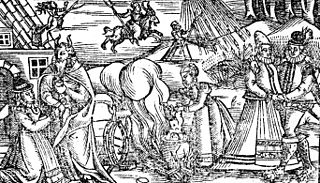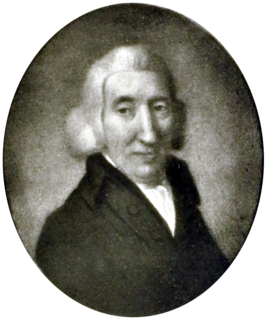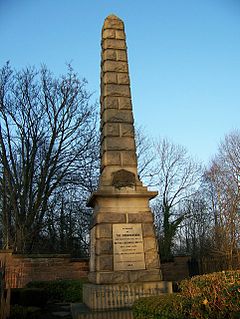Related Research Articles

The Book of Amos is the third of the Twelve Minor Prophets in the Tanakh/Old Testament and the second in the Greek Septuagint tradition. Amos, an older contemporary of Hosea and Isaiah, was active c. 750 BC during the reign of Jeroboam II, making Amos the first prophetic book of the Bible to be written. Amos lived in the kingdom of Judah but preached in the northern kingdom of Israel. His major themes of social justice, God's omnipotence, and divine judgment became staples of prophecy.

Charles II was King of Scotland from 1649 until 1651, and King of Scotland, England and Ireland from the 1660 Restoration of the monarchy until his death in 1685.
A prophecy is a message that is claimed by a prophet to have been communicated to them by a deity. Such messages typically involve inspiration, interpretation, or revelation of divine will concerning the prophet's social world and events to come.

Isobel Gowdie was a Scottish woman who confessed to witchcraft at Auldearn near Nairn during 1662. Scant information is available about her age or life and, although she was probably executed in line with the usual practice, it is uncertain whether this was the case or if she was allowed to return to the obscurity of her former life as a cottar’s wife. Her detailed testimony, apparently achieved without the use of violent torture, provides one of the most comprehensive insights into European witchcraft folklore at the end of the era of witch-hunts.

The Wars of the Three Kingdoms, sometimes known as the English/British Civil Wars, were an intertwined series of conflicts that took place between 1641 and 1653 in the kingdoms of England, Scotland and Ireland – separate kingdoms which had the same king, Charles I. The wars were fought mainly over issues of governance and religion, and included rebellions, civil wars and invasions. The English Civil War has become the best-known of these conflicts. It ended with the English parliamentarian army defeating all other belligerents, the execution of the king, the abolition of the monarchy, and the founding of the Commonwealth of England; a unitary republic which controlled the British Isles until 1660.

Alexander Peden, also known as "Prophet Peden", was one of the leading figures in the Covenanter movement in Scotland.

Robert Wodrow was a Scottish minister and historian, known as a chronicler and defender of the Covenanters. Robert Wodrow was born at Glasgow, where his father, James Wodrow, was a professor of divinity. Robert was educated at the university and was librarian from 1697 to 1701. From 1703 till his death, he was parish minister at Eastwood, near Glasgow. He had sixteen children, his son Patrick being the "auld Wodrow" of Burns's poem Twa Herds.

The Killing Time was a period of conflict in Scottish history between the Presbyterian Covenanter movement, based largely in the south west of the country, and the government forces of Kings Charles II and James VII. The period, roughly from 1679 to the Glorious Revolution of 1688, was subsequently called The Killing Time by Robert Wodrow in his The History of the Sufferings of the Church of Scotland from the Restoration to the Revolution, published in 1721–22. It is an important episode in the martyrology of the Church of Scotland.

The Battle of Rullion Green took place on 28 November 1666, near the Pentland Hills, in Midlothian, Scotland. It was the only significant battle of the Pentland Rising, a brief revolt by Covenanter dissidents against the Scottish government.

Robert Blair was a Scottish presbyterian minister who became a Westminster Divine and Moderator of the General Assembly of the Church of Scotland in 1646 after a failed attempt to emigrate to Boston in 1636. Born in Irvine in 1593 as the sixth son of John Blair of Windyedge, a merchant-adventurer and cadet of Blair, and Beatrix Mure of the Rowallan family, he graduated with an MA at the University of Glasgow in 1612 and appointed regent there in 1615. When the episcopalian John Cameron was appointed Principal, Blair resigned and went to Ireland, where he became minister of a Presbyterian congregation at Bangor, County Down. He was ordained to it by Robert Echlin, Bishop of Down and Connor, Blair was "very careful to inform... of what accusations had been laid against me of disaffection to the civil powers, whom he was the use of the English liturgy nor Episcopal government.... I declared my opinion fully to the Bishop at our first meeting... [who] said to me, 'I hear good of you, and will impose no conditions on you.'" Echlin, however, turned against him. In September 1631, Blair was suspended from his ministry and on 4 May 1632 deposed. Though bent on emigrating to New England, the ship in which he and other ministers sailed was driven back by weather, a sign, Blair thought, that his services were still required at home. He dodged an order for his apprehension by escaping to Scotland and was admitted to the Second Charge of Ayr in July 1638. After periods in Scotland and Ireland, he accompanied the Scottish army to England in 1640 and assisted in negotiating the 1641 Peace of Ripon. In 1646, Blair was elected Moderator of General Assembly, then Chaplain-in-Ordinary to King Charles I. He was also one of a Committee to endeavour in 1648 to get Cromwell to establish "a uniformity of religion in England." He was summoned to London by Cromwell in 1654, but excused himself on grounds of ill-health. On the establishment of Episcopacy he was removed from his charges in September 1661, confined to Musselburgh, then to Kirkcaldy for three and a half years, and then to Meikle Couston, Aberdour, Fife, where he died on 27 August 1666 and was buried.

Rev Dr Alexander Keith DD (1792–1880) was a Church of Scotland and Free Church minister, known for his writings on biblical prophecy.

The Battle of Bothwell Bridge, or Bothwell Brig, took place on 22 June 1679. It was fought between government troops and militant Presbyterian Covenanters, and signalled the end of their brief rebellion. The battle took place at the bridge over the River Clyde in Hamilton, South Lanarkshire near Bothwell in Lanarkshire, Scotland. The battlefield has been included in the Inventory of Historic Battlefields in Scotland and protected by Historic Scotland under the Historic Environment (Amendment) Act 2011.

Covenanters were members of a 17th-century Scottish religious and political movement, who supported a Presbyterian Church of Scotland, and the primacy of its leaders in religious affairs. The name derived from Covenant, a biblical term for a bond or agreement with God.

The Restoration was the return of the monarchy to Scotland in 1660 after the period of the Commonwealth, and the subsequent three decades of Scottish history until the Revolution and Convention of Estates of 1689. It was part of a wider Restoration in the British Isles that included the return of the Stuart dynasty to the thrones of England and Ireland in the person of Charles II.

Scottish religion in the seventeenth century includes all forms of religious organisation and belief in the Kingdom of Scotland in the seventeenth century. The 16th century Reformation created a Church of Scotland, popularly known as the kirk, predominantly Calvinist in doctrine and Presbyterian in structure, to which James VI added a layer of bishops in 1584.
Major Joseph Learmont was major in the Scottish Covenanter army. He was a tailor before he began his military career. He was proprietor of the lands of Newholm, near Dolphinton, which lay partly in the shire of Peebles and partly in that of Lanark.
Alison Pearson was executed for witchcraft. On being tried in 1588, she confessed to visions of a fairy court.
Events from the 1660s in the Kingdom of Scotland.
William Veitch was born on 27 April 1640. He was the youngest son John Veitch, the minister of Roberton, Lanarkshire. He was educated at the University of Glasgow, graduating with an M.A. in 1659. He became a tutor in the family of Sir Andrew Ker of Greenhead. He was licensed to preach by the Presbytery of Lanark in 1664. Having identified himself with the Pentland Rising, he was outlawed, and escaped to Newcastle, where he became chaplain in the family of the Mayor. In 1671 he was ordained to a meeting-house at Fallowlees, a remote spot among the Simonside Hills, Rothbury. From that he removed to Hanamhall, in the same district, and afterwards to Seaton Hall, Longhorsly. Whilst living at the latter place under the assumed name of William [or George] Johnston, he was arrested on 16 January, and sentenced to the Bass Rock 22 February 1679.. Veitch was liberated on 17 July 1680, and returned to Newcastle. He aided Archibald, Earl of Argyll, in his escape from Scotland in 1681. In 1683 he went to Holland, and in 1685 he was again in Northumberland acting as an agent on behalf of Monmouth. Soon afterwards he was settled as minister of a meeting-house at Beverley, Yorkshire. Having returned to Scotland, he was called to Whitton Hall, Morebattle, April 1688. In 1690 he was minister of Peebles, and in September 1694, he was admitted to Dumfries. He demitted on 19 May 1715. His death was on 8 May 1722. In 1705 he presented to the church two communion cups.
Louise Yeoman is a historian and broadcaster specialising in the Scottish witch hunts and 17th century Scottish religious beliefs.
References
- 1 2 3 4 5 6 7 Yeoman, Louise (2009). "Away with the fairies". In Henderson, Lizanne (ed.). Fantastical imaginations: the supernatural in Scottish history and culture. J. Donald. ISBN 9781906566029.
- 1 2 3 4 5 Ewan, Elizabeth; Pipes, Rose; Rendall, Jane; Reynolds, Siân (2017). The New Biographical Dictionary of Scottish Women. Edinburgh University Press. p. 351. ISBN 9781474436274.
- 1 2 Goodare, Julian (2019). "Seely wights, fairies and nature spirits in Scotland". In Pócs, Éva (ed.). Body, Soul, Spirits and Supernatural Communication. Cambridge Scholars. p. 229. ISBN 9781527522312.
- ↑ Stevenson, Jane (2012). "Reading, Writing and Gender in Early Modern Scotland". The Seventeenth Century. 27:3 (3): 337. doi:10.7227/TSC.27.3.5. hdl: 2164/5618 . S2CID 162393545 – via Taylor and Francis.
- 1 2 Simonova, N. "New evidence for the reading of sectarian women's prophecies". Notes and Queries. 60:1: 69.